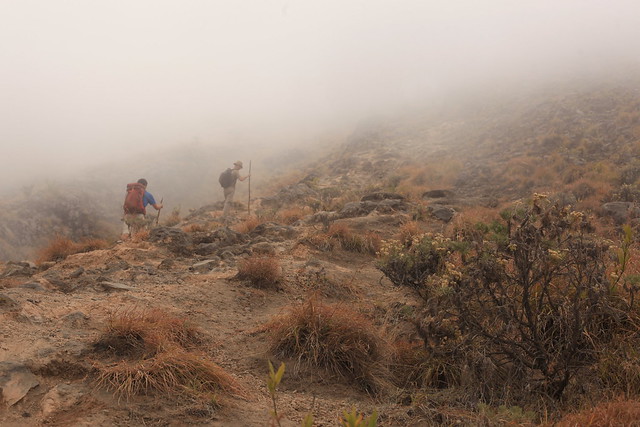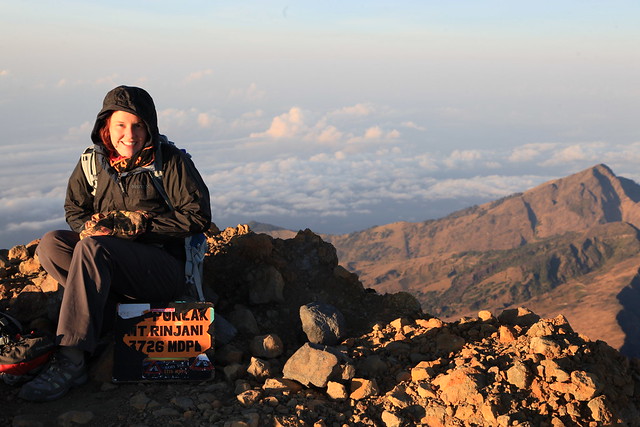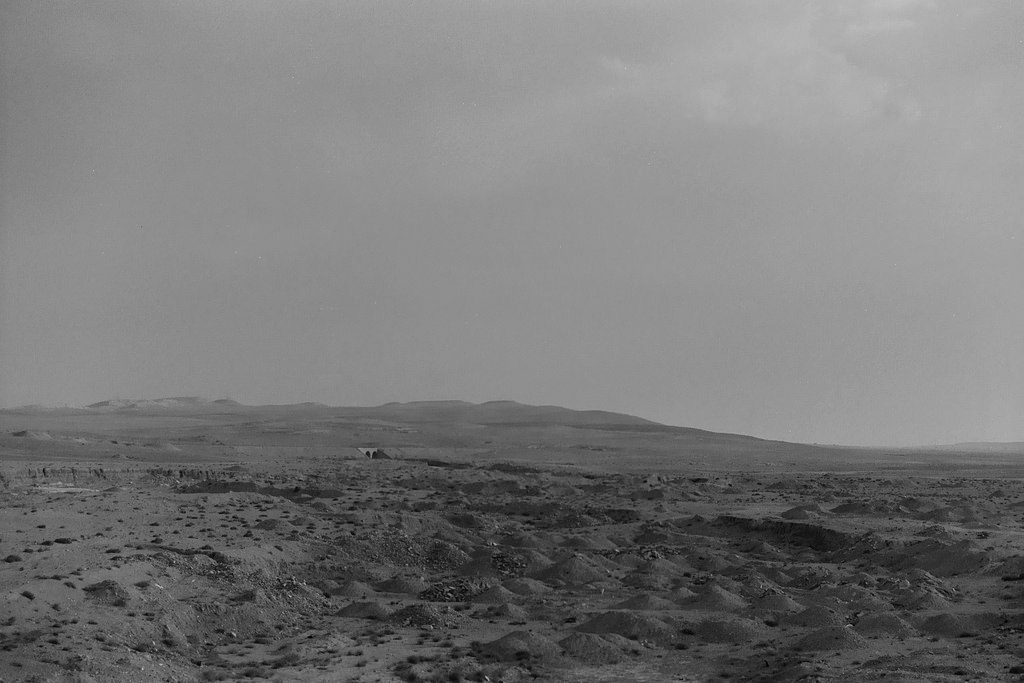A smooth twenty-minute water taxi ride landed us on the Gili’s big neighbour island, Lombok. By horse-and-trap then taxi, we finally saw Indonesian life in the daylight, lurching through overtaking manoeuvres past rice paddies dappled with the little sandy peaks of farmers’ straw hats. To one side, glittering gun metal grey beaches hinted at the volcanic foundations of the island chain.
Lombok is a similar size to Bali and a little further back in the race for development. Like its neighbours throughout the western end of the Nusa Tengarra chain, Lombok is a ring of palm-fringed beaches encircling, high, steep jungle-covered hills. Its northern half is dominated by Indonesia’s second highest peak, Gunung Rinjani. What I guess was once a huge singular peak had burst open in an ancient eruption to become a spectacular crater. We had seen it in guidebook photos months earlier and dreamed of reaching it. Now we were in its shadow.
At 07:00 we rose to Sunday morning in a near-empty guesthouse on the quiet road leading to Senaru, in Northern Lombok The stoop outside our room looked over a steep drop into a deep greem valley quilted with rice paddies. To the north, a faded patch of ocean, and in the opposite direction Rinjani’s peak, pertly standing over the source of Lombok’s clouds.
Our group gathered in the back of a flat-bed car; a German called Julia and a French couple, Marie & Bruno. Three porters packed three days’ worth of food, plus camping gear and bottles of mineral water, into reed baskets at the ends of bamboo yolks. Each hoisted his yolk onto one shoulder and set off ahead of the group. Our guide, Sab, walked amongst us carrying a modern rucksack.
It was hard work but not extreme. We walked on a dirt path up a consistent, steep incline through a forest dense with buttressed trees, palms and the calls of infinite insects, birds and monkeys. We soon spread out and lost sight of each other, with Maeve falling to the back, red-faced but uncomplaining. I pressed on but rested frequently, hiding behind trees or tight curves to surprise Maeve when she caught up. After about three hours we paused for lunch, surrounded by greyish macaques, sneaking guiltily in search of some food to steal. Sab and the porters laid out chicken, eggs, beans, carrots, cabbage, garlic, onion and spices. I took one of their handmade knives and chopped some of the tiny garlic and onion bulbs that were grown in the surrounding valleys. Clouds appeared suddenly through the trees and enshrouded us in their mist before vanishing as quickly again.
Another hour and a half climbing that track, over dirt and the natural steps of exposed roots, then we reached the treeline at aaround 1800m. The hard dirt turned slippery and loose, mixed with fine volcanic gravel. The route followed a ridge, bare and golden above the forest. In sections the path got steeper than before, and a tough slog became a lonely, torturous clamber.

Relaxing at the crater rim, with a mini-volcano in the lake below and the peak looming in cloud off to the left
The rain dwindled after about half an hour, as if cued by dinner and sunset. We took the few steps needed to stand on top of one of the rim’s minor peaks and looked down over the northwest corner of Lombok, back across to the sea and the low discs of the Gili Islands from which we had come. Far beyond, the geometric peak of Gunung Agung was rising over a wall of grey mist that hid Bali underneath it. A huge red sun set into that mist, colouring a narrow cleft of clear air surrounded by moody clouds and illuminating a curling curtain of rain that had previously enveloped us. The new moon appeared briefly as an orange sickle before falling into the same mist. Venus burst into flame, the clouds broke in sections and the Milky Way materialised again. Two huge shooting stars fell through the scene, one so bright it had a tail.
Starting early the next morning, we descended with trembling legs down steep switchbacks to the lake shore inside the crater. Following a ravine through the rim to the external face of the volcano, we were left to play in some hot springs while the support crew prepared lunch. Small waterfalls rolled over yellow rock into water the colour of sand. Steam rose from the surface. We edged into a plunge pool, slipping on the mineral-coated rocks, loweering ourselves into bath-warm water. We showered under the pounding falls and jumped from the sides.
After a big lunch of vegetables, chicken, egg and rice, we had an easy hour traversing the outside of the volcano, maintaining a similar altitude. Baking sun fell behind clouds and a cool breeze followed up the slope. Desolate pine trees stood sadly, draped in lank tufts of firs, amidst blanched grass and flowers, drifting in and out of the clouds billowing up the slope. The path turned to face up towards the crater rim and instantly became so steep we needed four limbs to climb, breathless for another two hours. We finally pitch camp back on the rim, this time on the north side, just under the summit, overlooking a wide, fertile valley leading to the sea.
Our support crew cooked a delicious yellow curry and supplied bottomless tea and water from the nearby springs. On the whole trek they kept us well fed, hydrated and sheltered, in spite of our isolation, all the time pounding the hill in sandals with the bamboo yokes on only one shoulder, raising swollen, whelted skin.
We watched another barely credible equatorial sunset, this time a huge red ball sinking behind the far side of the crater rim. Then we were settling into our beds at only 18:30.
Deep in the night we heard the wind rising, howling through the scant pines and shaking our tents. We rose at 02:30, presented with tea and crackers before setting off in total darkness, each only able to see the silver-blue pool of their headtorch light. We joined the rear of a train of hundreds of hikers attempting the summit, each demarkated by a light swaying up the ridge above. It was hard work from the first step, yomping through soft dirt up a steep incline, grabbing handrails and tree branches. We were frustrated by a jam of human traffic, puffing wordlessly over each step in front of us. But we slowly passed one straggler at a time until we were almost the lead group.
The ascent became desolate trudgery. Now there were no trees, just moon-grey rock surrounded by darkness. The peak never seemed to look any closer the whole way but the route finally steepen even more and weaved between macabre rocks that pointed daggers at the now lightening sky. We dug our fingers into the ash to aid our ever shrinking steps, duck-walking to minimise the constant slipping back. The predawn to our left threw unfurled like a green and orange banner announcing our arrival at the summit about two minutes before the same red ball we had watched vanish the evening before on the opposite side of the world emerged from a veil of cloud resting on the horizon. As dawn rolled out across the island, the peak threw a triangular shadow into the haze above the crater lake almost 2,000m below.
It was a steep descent for the first couple of hours, bounding through soft dust that clouded around our feet. The frozen air became burning heat. Scant firs became rolling savannah grasslands. We hardly stopped for a moment. The incline lessened and the path stretched out across the savannah towards a woodland, with our destination, the small town of Sembalun
The final hour took us through the cool trees, as rainclouds above and treated us to a brief shower. At the approach to Sembalun we passed through ferns and high grass, then cultivated fields of maize, bananas, peas, carrots, garlic and onions. Finally, amidst the business and noise of farming townsfolk, we reached a road, and a truck, and our finish.









Leave A Comment